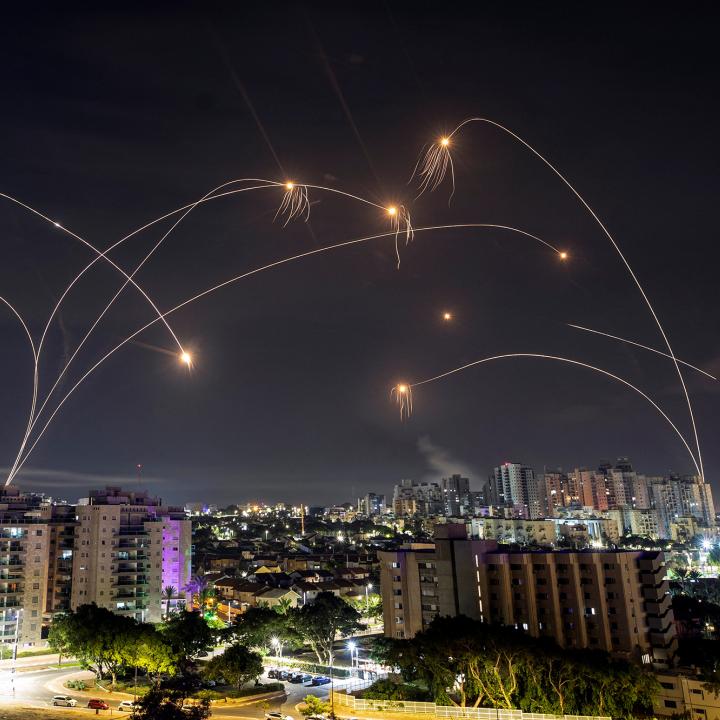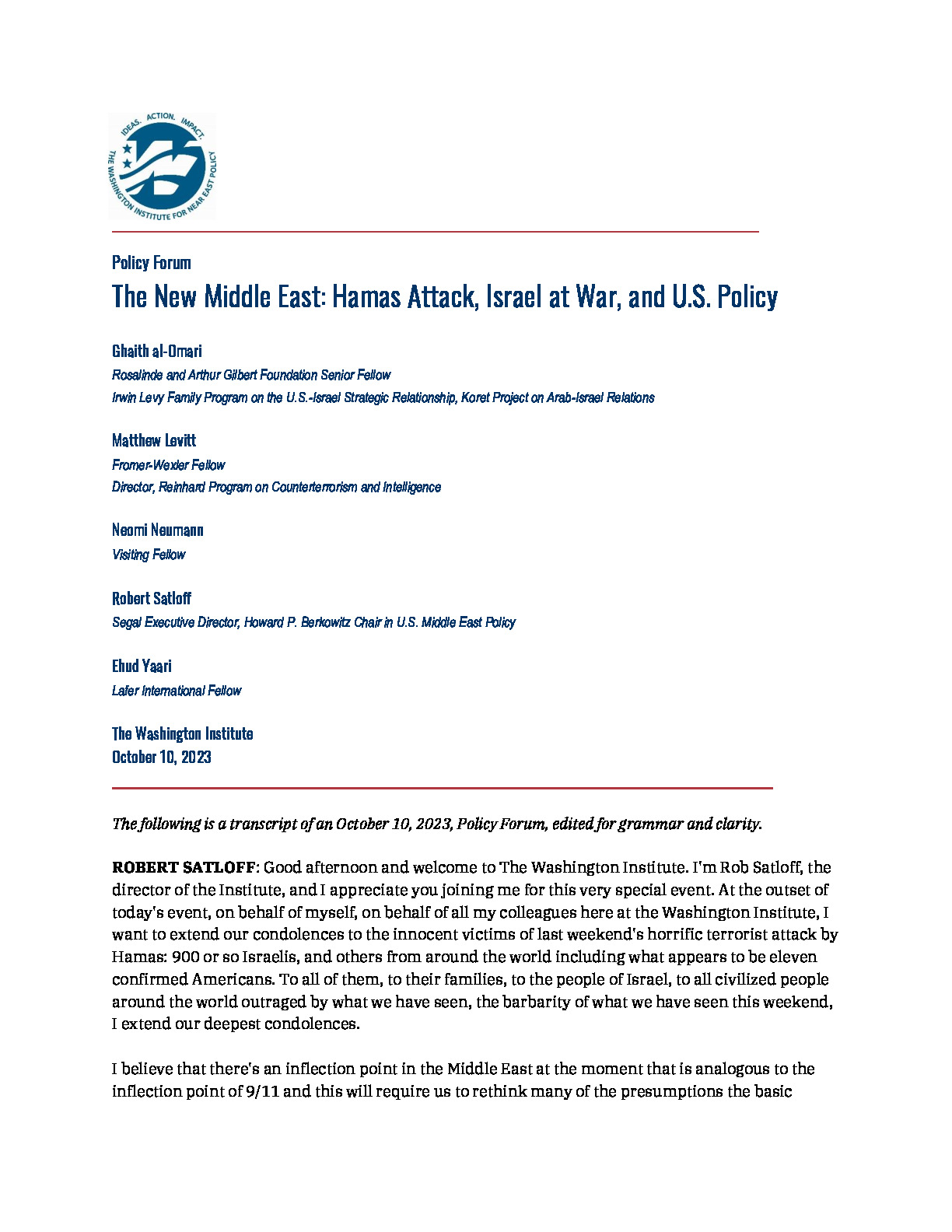
- Policy Analysis
- PolicyWatch 3797
The New Middle East: Hamas Attack, Israel at War, and U.S. Policy

Veteran U.S., Palestinian, and Israeli experts and policy practitioners explore the broader strategic repercussions of the unfolding war, as well as the factors that enabled Hamas to reach its current level of malign regional influence.
On October 10, The Washington Institute held a virtual Policy Forum with Robert Satloff, Ehud Yaari, Matthew Levitt, Neomi Neumann, and Ghaith al-Omari. Satloff is the Institute’s Segal Executive Director. Yaari is a Lafer International Fellow at the Institute. Levitt is the Institute’s Fromer-Wexler Fellow and director of its Reinhard Program on Counterterrorism and Intelligence. Neumann, a visiting fellow at the Institute, formerly served as head of the research unit at the Israel Security Agency. Omari is the Rosalinde and Arthur Gilbert Foundation Senior Fellow at the Institute. The following is a rapporteur’s summary of their remarks. To read a full transcript of the event, download the PDF above.
Robert Satloff
This moment is an inflection point in the Middle East, the scale of which is analogous to the September 11 attacks. This will require a rethinking of the basic paradigm through which the United States approaches politics, society, and conflict in the region.
Yet the September 11 analogy is inadequate to comprehend the impact and meaning of these attacks in Israel, for several reasons. First, the October 7 attack inflicted a dramatically higher number of casualties proportionally speaking. Second, Israel is far smaller than the United States, so the proximity of every Israeli to someone harmed in the attacks or deployed in response is much closer. Third, the attacks involved many cases of individualized barbarity, including rape. Fourth, terrorists continued to operate on Israeli soil for days after the attacks. Fifth, for the first time in the history of the Israeli-Palestinian conflict, a large number of hostages were taken across the border. Sixth, it appears that these attacks may be the first phase of a much larger conflict.
Analogies to the October 1973 war are inadequate as well. The Hamas attacks were certainly a surprise, and Israeli forces were not deployed properly in response. Yet Egyptian president Anwar Sadat launched the 1973 war to catalyze peace, leading to the Camp David Accords. Hamas certainly did not launch its attacks to make peace or advance a two-state solution—rather, it aimed to activate a multifront threat against Israel, fill a vacuum in Palestinian leadership, and stop progress toward regional peace, as exemplified by the potential Israeli-Saudi normalization agreement.
This is not just another phase of periodic conflict between Israel and Hamas, this is fundamentally different. Israel will seek to decapitate the group’s military leadership, destroy its residual military capability, re-instill public confidence in the Israeli government and military, and replace regional perceptions of Israeli vulnerability and weakness with images of power and invincibility.
These efforts will entail a substantial, extended military effort framed by the threat of wider conflict, including the Palestinian arena and, potentially, Lebanon, Syria, and Iran. U.S. and Israeli partners in the region will likewise have a vital role to play. Although Israel’s Arab partners were not directly targeted by Hamas, a weakened Israel leaves them more vulnerable. This was also the most significant act of terrorism against Americans outside U.S. soil since at least 2002; indeed, Hamas remains aligned with Iran in their shared fight against the United States and Israel.
Ehud Yaari
This is the darkest moment in the history of Israel since the 1948 War of Independence. Israel very likely had sufficient intelligence to anticipate a Hamas attack yet was still unprepared. On one hand, intelligence agencies did not expect a change from the type of violence Hamas has employed in previous conflicts. On the other hand, Israel’s technological superiority did not mean much in this case because the border fence around Gaza was improperly defended. Israeli guards were killed at their positions, and other forces took hours to intervene. In the Gaza envelope, where over twenty kibbutzim once stood, only one remains standing.
These attacks were most likely orchestrated by Iran’s Islamic Revolutionary Guard Corps in order to derail progress toward Israeli-Saudi normalization. Iran perceived such a deal as a direct threat to its security. Moreover, Yahya al-Sinwar, the Hamas leader in Gaza, has previously been unwilling to invade Israel without external support. Iran and Lebanese Hezbollah have very likely promised to open a northern front should Hamas’s military leadership appear to be in danger.
For now, Israeli leaders are still determining the time and manner of a major ground invasion amid ongoing airstrikes. The goal right now is to minimize Hamas’s ability to resist. The number of hostages held by the group is unknown.
Israel entered this situation with a government and prime minister discredited by more than half the population. Binyamin Netanyahu has taken days to determine whether to form a war cabinet with the opposition—while most Israelis are bridging the political divisions that were widened by the recent judicial overhaul, Netanyahu still appears bogged down in partisan politics
Matthew Levitt
There is a misconception that after Hamas took over Gaza by force in 2007, it moderated its commitment to jihadist activities and was coopted by governance. In fact, the group has gradually built an infrastructure unimaginable for most terrorist groups, including massive caches of small arms and rockets and a cadre of fighters to be used at a date of its choosing. Hamas fed this misconception, leading a disinformation campaign that convinced Israelis it could be deterred through economic incentives.
Hamas has now disproved the notion that governance would deter its terrorism; rather, it must be viewed as a group that can not only carry out standard terrorist attacks, but also deploy hundreds of fighters in coordinated attacks. Its goals are now undeniable as well: the group is not focused on ending Israeli occupation or achieving a two-state solution, but rather on destroying Israel and creating its vision of an Islamic state in all of historic Palestine.
Since the attack, the Israeli Air Force has focused on destroying as much of the group’s military capabilities as possible, including rockets, defensive elements, and tunnel systems. For its part, the United States will provide intelligence support to Israel, while the FBI’s extraterritorial squad will open cases for every American victimized by this attack. These efforts—along with regional shows of military strength such as naval redeployments—will probably be the limit of U.S. support. Domestically, law enforcement will focus on the potential for hate crimes in the United States.
Looking ahead, the risk of horizontal escalation may emerge via Hezbollah in Lebanon, Shia militias in Syria, and Yemeni Houthi rocket fire against southern Israel. Hamas perpetrated this attack with full knowledge that the Israeli response would be significant, so it very likely believes that Hezbollah and other Iranian proxies will open additional fronts if necessary.
Debates over Iran’s role in the attack miss the point, since Tehran’s decades-long support of Hamas makes it complicit under any circumstances. Even so, the nature and scope of the operation suggest that Iran and Hezbollah offered at least strategic guidance. In fact, this Hamas attack appears to come straight out of Hezbollah’s playbook—for years, the Israel Defense Forces Northern Command has trained to counter precisely this kind of cross-border operation. Whatever the case, Israel’s response will be fundamentally different from its responses to previous Hamas attacks given the number of victims, most of whom are civilians.
The attack also demonstrates why regional moderates must consider Iran and its proxies as serious threats. It is in their interests to coordinate with Israel.
Neomi Neumann
These attacks were a total surprise for Israel and necessitate a paradigm change in Gaza and perhaps the entire Palestinian arena. Israel’s immediate aim is to topple Hamas’s leadership, which will take a tremendous amount of time and effort and result in substantial Israeli casualties. At the same time, Israel must work with international partners to plan the reshaping of the Middle East and the Palestinian arena after Hamas is defeated.
When the group first took over Gaza in 2007, Israel responded by blockading the Strip. Yet this approach did not produce the intended result, instead jeopardizing Israel’s security and interests due to the looming threat of humanitarian crisis. Without a proper solution—and in light of the fact that neither Israel nor the Palestinian Authority (PA) wanted to return to Gaza—a temporary coexistence of sorts emerged between Israel and Hamas. The group’s pragmatic actions during this period were misunderstood as gradual moderation of its ideology. While Israel eased components of the blockade, Hamas built up its military capabilities in multiple arenas. Time and time again, when given the choice between the interests of Palestinian civilians and its own military interests, Hamas chose the latter.
A turning point for Hamas came during Israel’s 2021 Operation Guardian of the Walls. That round of conflict not only saw Hamas launching rockets from Gaza, but also included Palestinian communities in East Jerusalem and the West Bank carrying out unified anti-Israel actions of their own. This development showed Tehran and Hezbollah that cooperation with Hamas could weaken Israel and turn its focus away from Iran.
Indeed, Iran has long provided inspiration, support, funds, means, and expertise to Hamas. The group trained for this attack for a long time and likely saw recent developments in Israel as evidence of weakness. Moreover, the nature of its actions this week indicates that it remains a radical movement singularly focused on the destruction of Israel.
As for the “day after Hamas,” Israeli planning for that stage should begin right away in cooperation with the United States, international bodies, regional countries, and the PA. This will enable efforts to reshape the Palestinian arena and, to a large extent, the Middle East as well.
Ghaith al-Omari
Palestinian society, like all other Arab societies, has always had Islamist components. Historically, Islamists remained outside the “liberation struggle” in the Palestinian arena. This changed in 1987 during the first intifada, when the Palestinian branch of the Muslim Brotherhood created Hamas. Back then, however, Hamas was little more than a violent irritant.
When the Oslo Accords emerged, however, Hamas distinguished itself from the Palestine Liberation Organization through its strong opposition to any form of accommodation with Israel and its commitment to violence. During the second intifada, Hamas rose to prominence by perpetrating terrorist attacks against Israel, and its reputation was further validated when Fatah adopted some of the same tactics.
By 2006, Hamas was exploiting the trauma of the second intifada to win parliamentary elections on a platform opposing PA corruption. After the civil war between Fatah and Hamas in 2007, the group took over Gaza and has been the governing authority in the Strip ever since.
Alongside its continued terrorist objectives, Hamas has used governance to legitimize itself in international discourse. The group receives support from Iran, of course, but also from Qatar and Turkey, both of whom advanced its rebranding. For example, some international actors commended Hamas’s 2017 “political document” stating it would accept a Palestinian state along the pre-1967 borders. Yet these voices ignored the fact that the document did not represent a formal amendment to Hamas’s charter, which continues to reject Israel’s existence.
Since then, Hamas has faced various governance challenges in Gaza. Like the PA, it has engaged in rampant corruption and is now unpopular and compelled to govern by force.
The group has also shifted significant focus to the West Bank, where it has three primary objectives: opening another front for terrorist attacks, mobilizing West Bankers toward a third intifada (which the PA has taken steps to prevent), and seeking the collapse of the PA itself. Although Israeli policy in recent years has certainly weakened the PA, Ramallah is largely at fault for its weakness due to corruption and poor governance. Today, most Palestinians view the PA as a liability.
Hamas also likely hoped that this week’s attacks would spark intercommunal violence between Arab and Jewish Israelis, perhaps fanned by members of the Israeli government. Instead, key Israeli politicians such as United Arab List chair Mansour Abbas have urged de-escalation.
No matter how this war ends, Hamas must not be permitted to demonstrate any success from the use of terrorism. One way to facilitate that goal is to include regional partners like Egypt, Jordan, and the United Arab Emirates in any future mediation efforts—while excluding Hamas supporters like Qatar and Turkey from any talks besides hostage negotiations.
Finally, the PA would be incapable of immediately taking control of Gaza in the war’s aftermath, and this shortcoming cannot be solved through financial aid alone. PA institutions must be reformed and rebuilt in the West Bank first, and later in Gaza.
This summary was prepared by David Patkin. The Policy Forum series is made possible through the generosity of the Florence and Robert Kaufman Family.







